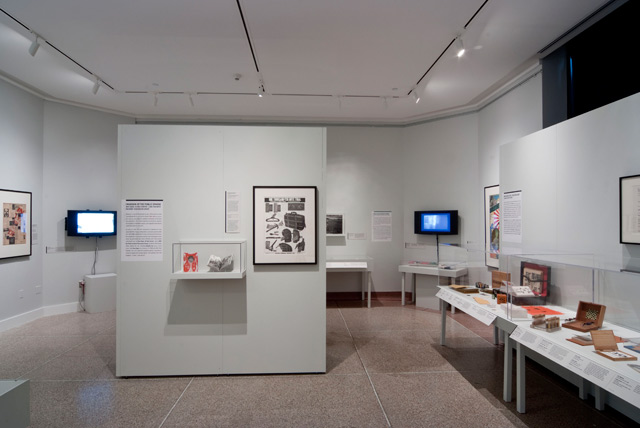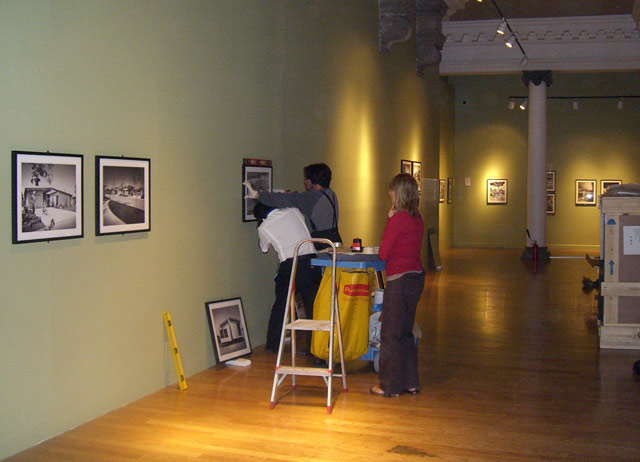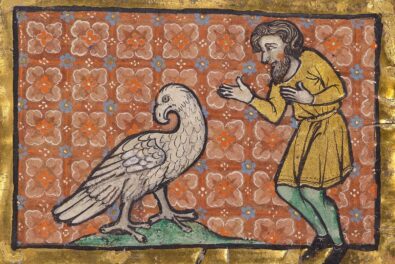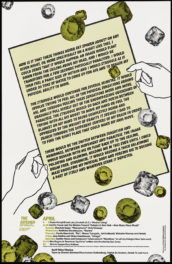
Installation view of Art, Anti-Art, Non-Art: Experimentations in the Public Sphere in Postwar Japan, 1950-1970 at the University of Michigan Museum of Art. Photo: Randy Stegmeyer
Off the tram, up the stairs and take a sharp right before going into the main entrance pavilion. Head into the building across from the Cafe. That’s where you’ll usually find the distinctive exhibitions of the Getty Research Institute (GRI).
But you could also see GRI shows in Ann Arbor, Guadalajara, Madrid, and Evanston, Illinois. The Research Institute’s curators focus on exhibiting our extraordinary and sometimes challenging collections to the public in interesting and accessible ways. And part of that includes travelling our exhibitions to other venues.
GRI director Thomas Gaehtgens put it to me this way: “GRI exhibitions explore new fields of art historical knowledge, so it’s important that these shows travel to other places, where our materials and new methodologies can encounter a larger public.”
Most recently, Art, Anti-Art, Non-Art: Experimentations in the Public Sphere in Postwar Japan, 1950–1970, originally on view at the GRI in 2006, opened at the University of Michigan Museum of Art (on view through this Sunday, June 6). Each time an exhibition travels to a new venue, a revised layout and installation plan is needed. For Art, Anti-Art, Non-Art, which includes a number of unconventional objects, such as Fluxus kits, preparing the exhibition for another venue was particularly challenging.
The GRI team (curator John Tain, conservator Albrecht Gumlich, mountmaker Kevin Young, and me) worked closely with our colleagues in Michigan on the display for their show. Even so, questions arose during installation. Is it okay to use acrylic rods to prop open parts of a Fluxus kit? Can three books that were shown closed at GRI be open to interior spreads? Can they add D-rings to some of the framed works? The result is a beautiful and engaging display.
A related program underscores how traveling exhibitions encourage new examinations of GRI materials. In conjunction with the exhibition, the Museum hosted a two-day symposium entitled Saying Yes to Say No: Art and Culture in Sixties Japan.
Until recently, our traveling exhibitions had been strictly domestic, but as of November 2009 we could begin to boast that our shows travel internationally. Julius Shulman’s Los Angeles, originally organized for the Los Angeles Public Library in 2007, traveled to Guadalajara, where it was on view from November 27, 2009, to January 10, 2010, at the University of Guadalajara Museum of Art, and to Canal de Isabel II in Madrid, where it was exhibited from February 16 to May 16, 2010.
The exhibition’s curator, Christopher Alexander, and designer, Maria Velez, worked together to reconfigure the show so that it would fit in its new venues—one of which was a converted, five-story water tower. Christopher and Maria traveled to both venues to oversee installation. (Sounds glamorous, but a vicious stomach ailment waylaid one of our team members in Guadalajara, and bitterly cold, rainy, and windy weather dampened Madrid’s pleasures).

Maria Velez overseeing the installation of Julius Shulman’s Los Angeles at the University of Guadalajara Museum of Art

Installation view of Julius Shulman’s Los Angeles at Canal de Isabel II in Madrid
In 2011, we’ll install a second exhibition organized especially for the Los Angeles Public Library, A Nation Emerges: The Mexican Revolution Revealed. Opening on May 5 (Cinco de Mayo), this exhibition will include prints and photographs of Mexico’s leaders—appointed, elected, and revolutionary—as well as ordinary figures.
From September 23 through December 11, Tango with Cows: Book Art of the Russian Avant-garde, 1910-1917 will be on view at the Block Museum, Northwestern University. The exhibition will be part of a Chicago-wide project, “The Soviet Experience,” a festival of visual art, music, dance, and performance created by artists of the Soviet Union. The Block Museum also has a concurrent exhibition in the works, Views and Re-Views: Soviet Political Posters and Cartoons.
Traveling GRI exhibitions expands the reach of our scholarship and engages new audiences. Whether it’s across town at the Central Library or across the globe in a converted water tower, our goal is to continue to inspire new dialogues and inquiries.




Comments on this post are now closed.
Trackbacks/Pingbacks